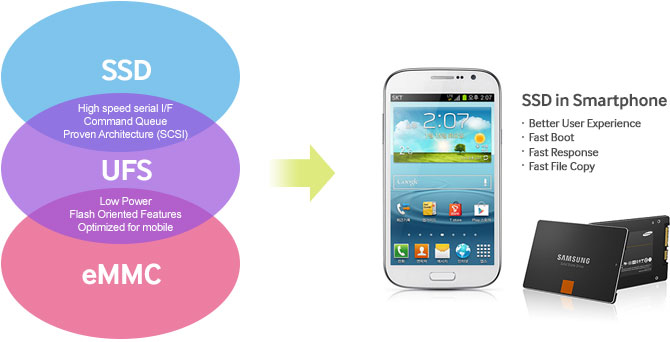Samsung, Xiaomi Moving To Next-Generation UFS 2.0 Memory Standard In 2015
According to recent reports, Samsung is planning to replace the internal eMMC and microSD storage technologies in the Galaxy S6 with UFS 2.0 (Universal Flash Storage), which is supposed to be the next-generation NAND flash-based memory standard.
"UFS is an important element for our smart phone business next year. We will start the application centering on flagship smart phones," a Samsung Electronics insider told ETNews. "However, we cannot disclose any details because the time of a new smartphone release next year and specifications of this new model have not been finalized."
Xiaomi, which is now ranked third in global smartphone sales, is also planning to use the same storage standard in its phones next year, according to ETNews' sources.
The UFS standard is backed by companies such as Samsung, Micron, Nokia, SK Hynix and Toshiba. It's developed by the Joint Electron Device Engineering Council (JEDEC), the same organization in charge of developing the eMMC standard so far. UFS 2.0 supposed to reach interface speeds of up to 1.2 GB/s, which is three times faster than the most cutting edge eMMC 5.0 storage.
Although it can be much faster, it uses the same or even lower energy than eMMC storage. Smartphone OEMs could also configure whether they want the maximum performance and similar power consumption, or lower performance with significant power savings.
Samsung hopes to dominate the UFS market much as it did with the eMMC-based memories, and it has apparently already started mass-production of such memories. UFS storage is expected to arrive in smartphones, tablets and cameras.
With high-end smartphones and cameras starting to shoot 4k video at 30 fps and presumably going to 60 fps later (or 720p 240 fps slow-motion video and probably 1080p 240 fps soon as well), we'll need to have ultra-fast storage that can handle receiving such amounts of data in real-time without any system slow-downs. UFS 2.0 and its adoption seems to arrive at the right time, just when we needed it.
Get Tom's Hardware's best news and in-depth reviews, straight to your inbox.
This type of memory is likely to be more expensive in the first year or two due to its novelty and higher performance, but if all memory makers adopt it soon, the prices should come down quickly. Either way, we're unlikely to see a regression of the amount of storage we see in new phones. OEMs should continue to put the same or more memory in new flagship devices next year. External UFS 2.0 memory cards, on the other hand, might end up being more expensive for a while.
Follow us @tomshardware, on Facebook and on Google+.
Lucian Armasu is a Contributing Writer for Tom's Hardware US. He covers software news and the issues surrounding privacy and security.
